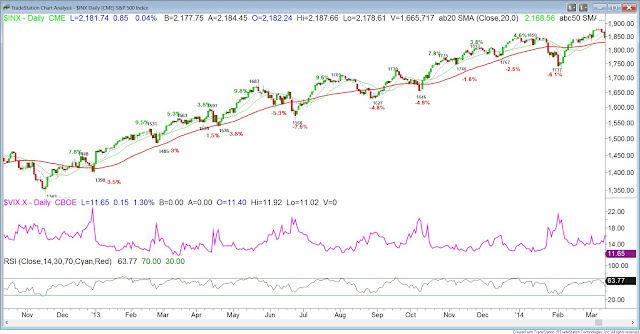With that in mind, we wanted to take a look at some of the forces at play that will determine whether the recent trend continues higher. In the very near-term, we continue to see some negative divergences and short-term warning signs that will need to be worked off but overall things continue to look healthy for higher prices. Hopefully any pullback will be similar to some of the past instances shown in our last blog post i.e. shallow and short
Breadth
- We're seeing some short-term negative divergences as the % of stocks above their 10, 20, and 50 day moving averages peaked out in July (1st chart)
- Also, the number of 52-week new highs on S&P peaked in July (2nd chart)
- Good news is the longer-term looking indicator of % of stocks above their 200-day is hitting highs with the market
- The advance-decline line is also confirming price strength (A-D line in yellow in 2nd chart). This is a good thing.
Sentiment
- Plenty of cash is still on the sidelines as shown by the 5.4% cash weighting of fund manager allocations (this according to the BAML Global Fund Manager Survey).
- Managers are also only 9% overweight global equities which is almost a full standard deviation below the historical average.
- CNN Fear and Greed Index is has gotten excessive and is now flashing "extreme greed."
- AAII survey is at 5 week high but bullishness is still below historical average. Still very high neutral readings.
AAII Sentiment Survey:
Optimism is at a five-week high, as more than one out of three respondents described themselves as bullish for just the sixth time this year.
VIXThe VIX term structure remains historically low but as we have shared in previous posts this doesn't necessarily mean we should be ringing alarm bells.
In the short-term there are a few negative divergences worth watching coupled with some sentiment measures being a bit overheated. This becomes even more important as we enter September which has historically been the worst month of the year.
However, this is also to be expected at the beginning of what could be a new uptrend. The so-called "wall of worry." Case in point, according to the monthly BAML fund manager survey, investors are still pessimistic with only 23% of fund managers expecting a stronger economy in the next year. This explains their low allocations to equities and high allocations to cash. However, the potential for more to hop aboard the bullish thesis could put a healthy bid underneath the market and keep prices propped up.











